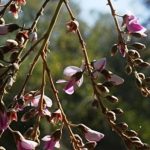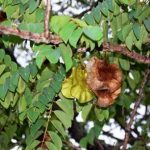TREE LIFE
FEBRUARY 1996
MASHONALAND CALENDAR
Tuesday 6th February. Botanic Garden walk at 4.45 for 5 p.m. We will meet Tom in the public car park of the Gardens, and continue where we left off last month. There will be a guard for the cars.
Sunday 18th February. We are very pleased to be invited to John and Lilian Cottrill’s farm in the scenic Mtepatepa district. Apart from an interesting rocky area where John has planted additional indigenous trees, his collection of water lilies from around the world should be flowering. As a bonus, Lilian, who is a renowned bird artist, might show us her studio and some of her paintings. Meet at 9.30 a.m.
Sunday 25th February at 2.00 p.m. A walk in the Chinamora CL to see terrestrial orchids, this time Habenaria and Satyrium with Werner & Virginia Fibeck.
Tuesday 5th March. Botanic Garden Walk.
LONG TRIPS
If you are interested in any of the following trips please contact Maureen Silva-Jones.
Thursday 29th Feb. to Sunday 3rd March. RIFA, the hunters camp at Chirundu. Maximum 30 people. First come basis. Details will be finalised soon. (5 places left).
April 5th to 8th Easter. Accommodation for 24 has been reserved at Ezulwini in Nyanga. First come basis. (7 places left).
August 18th to 31st? A trip to Cape Town is being considered to see the famous Fynbos. Own transport with a possibility of camping along the way. 20 people. Details later. Please note corrected dates.
MATABELELAND CALENDAR
Sunday 4th February. An all day outing to the Matopos. Depart promptly from the Girls’ College car park at 8.30 a.m.
Sunday 3rd March. Morning only at Chesa Research Station.
The Botanic Garden Fence Fund now stands at $1200. Thank you for your donations. Our aim is $3000, so we are not halfway there yet, but with Christmas over we can now concentrate on this very worthwhile project.
East Kana Estates 1-3 December 1995.
After eight hours travelling it was perfect to be able to space out on Tom and Mary’s huge verandah and look out over the shallow valley – a sea of fresh green Mopane responding to the first rain a few weeks earlier. Away to the west a few low hills popped up near to the Shangani River and to the north the thin blue line of an escarpment above which the enormous anvils of clouds were building up bringing a promise of further rain. Memorable sights on the trip from Bulawayo were the sheets of water lying vleis and the clusters of lilies, Crinum macowanii, flowering in profusion with their pink trumpet blooms hanging limply in the humid afternoon air.
Saturday. A walk along the Shangani River sounded like an excellent way to start the day and once charged with coffee and Mary’s chocolate cake, the convoy moved at a true Tree Society speed. And as maps had been forgotten Chris Fagg came to the rescue with an ingenious invention called a GPS (Global Positioning System). This handheld device produced the degrees East and South of Greenwich at the flick of a switch as well as ground speed – amazing!
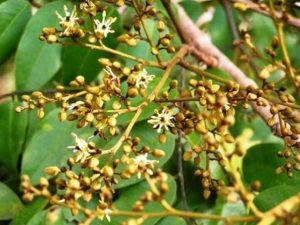
Dialium englerianum. Photo: Jos Stevens. Source: Flora of Zimbabwe
Our route to the river was interrupted after 100 metres by a large Erythrophleum africanum and a small Dialium englerianum causing the lead vehicle to stop suddenly. The next stop was on bare Karoo sandstone which contained scrubby Acacia nilotica, very spiny Balanites aegyptiaca, Baphia massaiensis shrub-like and with a mass of attractive white flowers and a pleasant sweet scent. Aloe chabaudii with exceptionally large dried inflorescences and Bauhinia petersiana in dense thickets covered with delicate white flowers. The ear-rendering screech from the cicadas, darting about on transparent wings, followed our route until the riverine grassland. At the banks of the dry Shangani River a satisfying mix of Acacia was found with both subspecies of magnificent flat crowned Acacia tortilis occurring here with Acacia nigrescens and two which I know only from the Botanic Gardens – Acacia fleckii and Acacia erubescens. Briefly, the latter was a spreading tree of layered appearance with a yellowish bark, whereas the other taller tree had a striated bark. At this point the ingenious G.P.S. indicated an altitude of 893 metres before venturing on noting Combretum imberbe and more Acacia nilotica which according to Chris is used as a hardwood in North Africa. This particular area also contained the typically lowveld form of Acacia sieberiana with a greeny-yellow trunk occurring in various spots as well as some large ones on a slope near the “unattached males” chalet. It was this particular form of Acacia sieberiana that intrigued us at RIFA in May. From the river banks dotted with Ilala palms, Hyphaene petersiana, we had to trudge through the deep sand of the dry riverbed to reach an extensive block of Mopane woodland on the opposite side. Here we found deep within the green gloom an exceptionally tall Cadaba termitaria (we’re not used to climbing ones in Mashonaland) using a tree trunk for support and heading for the sunlight. Chris and Jonathan were discussing the attributes of Acacia gerrardii when we returned from our woodland amble to the river bank. From here into groves of Faidherbia albida following the broad swathes of alluvium and clusters of the apple-ring pods scattered around. These trees follow their curious pattern of remaining leafless during summer, rather like a postcard view of Mana Pools minus the elephants. A solitary Trichilia emetica and a few clumps of Rhus quartiniana rounded off the walk except for another look at the Acacias.
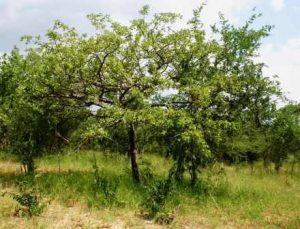
Commiphora mossambicensis. Photo: Bart Wursten. Source: Flora of Zimbabwe
Back to the house for brunch before the long walk back to the dam. Those who had seen it a day earlier enthused about the area so we followed Ian and along this route we noticed branches of Commiphora mossambicensis snapped off and strewn about. Was it eland using their horns as levers or some other herbivore making sure the soft new leaves could be sampled? Some of the other species not that familiar were fruiting Carphalia pubescens, shiny green Erythroxylum zambesiacum so easy to confuse with the snowberry Flueggea virosa, fiercely spiny Canthium glaucum subsp. frangula colonizing the roadside. The crocodile-bark Diospyros quiloensis was also common in this area. A magnificent bird plum Berchemia zeyheri on the roadside had also been spotted by the ‘walkers’ in front as a series of scratches were left in the road surface evidently supposed to alert us, but seen only on the return trip – apologies to Ian and Co.
The dark clouds building up far away to the west had gathered overhead almost unnoticed. First came the smattering of light rain followed by the heavy drops. Within a few minutes the dry earth turned to a sheet of mud and from the trickles small streams built up making the return trip of the ‘intrepid’ rather hard going sloshing through deep mud and streams. Anton and I sheltered under a tree which we later found out was only a hundred metres from the house! A later trip to find the seeds that Anton had seen, this time in Jill’s 4×4, was shortened finding only a fruiting Pseudolachnostylis as another storm surged through the woodland. A little later under the thatched verandah in between pressing plants and fighting Acacia specimens we toasted Sharon and Mario on the occasion of their engagement, with some wonderful champagne produced by Mario, and wished them every happiness for the future.
Sunday. 6 a.m. and another early start to follow the boundary line near the boma and some Terminalia trichopoda or one of those ghastly hybrids. Some tall examples of Teak, Baikiaea plurijuga, more Schinziophyton rautanenii (the Mugongo Nut previously known as Ricinodendron) which are supposed to hold water in holes within the squat pale trunks. And Schrebera trichoclada, where the tiny (perhaps aborted) wooden pear fruits were spread near a prospecting claim, this being one of the E.P.0’s for natural gas. Some enormous clusters of Phyllanthus reticulatus, alas no potato smell, in this area with an occasional Combretum mossambicense, heavily browsed with only a few stubby spurs remaining, to the false Mopane, Guibourtia coleosperma, a new one for me, had leaves resembling Mopane and pale smooth bark. As for the insects busy after the previous day’s rain, Chongololos with yellow legs wrapped around tiny yellow mushrooms clustered on a rotten Terminalia trunk. And the shiny black dung beetles doing their thing in reverse or buzzing about in crazy circles scenting for fresh dung on the crisp morning air.
All too soon it was time to return, do justice to the wonderful breakfast, pack and begin the long homeward trek. To Tom and Mary, we thank you so much for a splendid weekend and for the superb catering. Please may we return sometime to this fascinating area?
0ur thanks also to Chris Fagg and Jonathan Timberlake for their help especially with Acacias and for the use of the G.P.S.
-A. MacNaughtan
Mbizi 10th December 1995
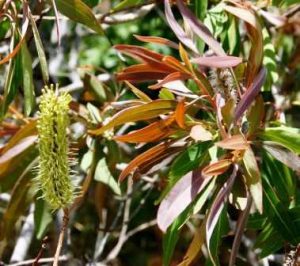
Faurea saligna. Photo: Bart Wursten. Source: Flora of Zimbabwe
Mbizi Game Park situated on part of the original Arlington Estate is located between two old favourites of ours, Chedgelow and Lyndhurst. We expected to see quite a variety of trees as this is an interesting area but not as many as the 90 species recorded. The thatched pink A-frame with Rhus tenuinervis at each of the entrances and a flowering Faurea saligna really made an ideal meeting place before heading off a couple of km to the Aloe Forest – a series of shallow rocky outcrops, with a large number of exceptionally tall Aloe excelsa. Many of these plants which must have been approaching the 20 ft. mark grew in and with colonies of Aloe chabaudii clustered within the rocks and must be a magnificent sight when flowering during the winter months. From a vantage point on a large flat rock where the parasites Loranthus sp. and Viscum sp. initially defied efforts to attach labels, some very attractive large white blooms of Rothmannia fischeri appeared below from a canopy of Brachystegia glaucescens and Msasas Brachystegia spiciformis.
On the fringe of the Brachystegia woodland and responding to the recent rains were Peltophorum africanum the African Wattle, covered in yellow flowers, Dichrostachys cinerea with its dangling Chinese lanterns and Ochna schweinfurthiana well past its flowering with only the red curled calyxes remaining. Some of the others, Lannea discolor true to its name with marked colour variation between upper and lower leaf surfaces, Ficus thonningii, very large and supporting a sizeable and active beehive half way up the trunk. Foetid smelling Clerodendrum glabrum and Clerodendrum myricoides were noted along with Monotes glaber, Elephantorrhiza goetzei in the rocky crevices, small Euphorbia ingens and Euclea natalensis with sooty-like underside of the leaves.
An excited call from Cheryl upset a meandering vine snake in a small Snake Bean tree, Swartzia madagascariensis, and the serpent rippled away up and into the foliage, the little forked tongue flickering rapidly as it scented the human presence. Often these snakes will remain motionless for hours, sometimes the only visual feature being the rapid tongue flicker from what appears to be a dead branch. When close it is easy to see the long slender body and its bulbous head. After the snake one of Nature’s fruit dainties, Ximenia caffra, the sour plum, dripping in red fruits and temptingly close to the path brought the Garden of Eden to mind. These fruits are peeled using the front teeth and by keeping the tongue away from the bitter skin are, depending on your taste, exciting to suck.
Back to the A-frame with Christmas festivities already in progress and in the midst of it all everybody found a quiz sheet, keeping company with their glass or brown bottle, ready to probe minds with questions including references to such things as interpetiolar stipules … and to identify the seeds making up Santa’s face including Mopane seeds for eyebrows! The quiz was won by none other than the Haxens with full marks – well done! There were also prizes for identifying drawings of trees showing leaves, fruits and flowers. This bit of fun was essentially to raise funds for The Bot. Garden Fence Fund, and happily $324 was added to the kitty. Thank you for your generosity.
Just before the quiz ended the stormy sky whipped up the wind and the heavens opened, the thatch saving our gathering from an abrupt end. Very many thanks indeed to Mervyn Senior and John Parsons for the use of their facilities for the outing and also many thanks to Maureen for setting the quiz and producing the identification cards.
-Andy MacNaughtan
The following extract is from Veld & Flora, December, 1995. The article is by Terry Olckers, Plant Protection Research Institute, Pietermaritzburg and John Hoffmann, Zoology Department University of Cape Town and is reproduced with permission of the Executive Officer of The Botanical Society of South Africa, to whom we are most grateful
80 years of Biological Weed Control.
Since the early part of the last century, alien plants have caused major environmental problems in southern Africa, with very few habitats immune to invasion. Unwanted immigrant plants form dense thickets which, besides being aesthetically displeasing, disrupt the flow of rivers, clog wetlands, smother indigenous vegetation and degrade the biodiversity and function of natural ecosystems. In many instances invasive plants are a major threat to endangered species of fauna and flora.
Although some invasive alien plants were imported into the subcontinent by accident (contaminants in agricultural produce), a staggering 75% were deliberately introduced either as ornamentals (like Lantana camara), food plants (prickly pear Opuntia ficus-indica) or because they had other desirable attributes (Australian Acacia species produce tannin, timber, firewood, and are used for stabilising sand dunes). Indeed, several species were propagated and distributed by Government departments who vigorously encouraged land owners to utilize them as ‘wonder plants’, a practice that still continues.
What is biological weed control?
Indigenous plants never become weeds in undisturbed natural habitats because, among other reasons, their growth is continually suppressed by natural enemies (herbivorous insects, mites, nematodes and microbial pathogens), many of which are specialists and are only able to develop on a single species of plant. Alien plants are freed from their natural enemies which are deliberately or inadvertently excluded when seeds or cuttings are transported between continents. Therefore, once established on a new continent, they have few constraints and are able to out-compete the indigenous plants.
One way of alleviating the problem is biological control (using natural enemies to control a pest species). Surveys are made of the pest species in its country of origin to find suitable natural enemies. Intensive studies ensure that each potential natural enemy is host specific (able to survive on the weed only). This is determined by exposing both adults and immatures to a range of test plants, including crop species and indigenous species, especially those that have features in common with the target weed. Natural enemies that are able to develop on any of the test plants are immediately discarded while those that prove to be hosts specific are cleared for release. Once permission for release has been granted, large numbers of individuals of the selected natural enemy are collected and shipped to the country where they are needed. Colonies are reared under strict quarantine conditions (to eliminate any parasites and diseases and to bolster numbers) after which they are released where the invasive target weed is a problem. If the venture succeeds, self-sustaining populations of the agents become established and, if the agents are damaging enough, the growth and reproduction of the weed is suppressed to the extent that the plant populations dwindle to levels where they are no longer a problem.
The importation of natural enemies for biological control of alien weeds has become common practice in at least 75 countries, with nearly 300 species of natural enemies released on about 150 weed species. Most of the agents have been herbivorous insects, but fungal pathogens have been increasingly used with great success. Mites and fish have also played a role in some programmes
Early biological weed control
The earliest record of successful biological weed control dates back to 1836, when a cochineal bug (Dactylopius ceylonicus) from Brazil was released in southern India to combat an invasive cactus, Opuntia vulgaris (smooth prickly pear). Cochineal insects cause considerable feeding damage because their saliva contains toxins which poison the cactus, and within a few years Dactylopius ceylonicus had all but annihilated the infestations of Opuntia vulgaris in India. Following this success many countries imported Dactylopius ceylonicus for biological control of Opuntia vulgaris, including South Africa in 1913.
This was the first biological control programme against a weed in South Africa and it demonstrated how effective the method could be. Opuntia vulgaris was first recorded in South Africa in 1772 and by the late 1800s impenetrable thickets of the weed covered vast areas, particularly along the eastern Cape and Natal coastline. The onslaught by Dactylopius ceylonicus was spectacular and infestations rapidly destroyed.Their inaugural campaign demonstrated the safety of biological control and helped dispel the myth that once imported organisms have ‘eradicated’ a weed they will ‘switch’ to non-target plants. The development and survival of specialist (host specific) insect herbivores are closely tied to characteristics of their host plants. The plant must feel, smell and taste right before it is recognized as a suitable host; the seasonal cycles of the plant and the insect herbivore must be synchronized; and the insects must be able to cope with the combination of toxins that characterize most plant species.
Nothing further was attempted until the 1930s when biological control of weeds made international headlines with the spectacular control of another cactus weed (Opuntia stricta) in Australia by an introduced Argentinean moth (Cactoblastis cactorum). In South Africa programmes were initiated against this and two other cactus weeds, prickly pear (Opuntia ficus-indica) and joined cactus (Opuntia aurantiaca). In the 1930s, thickets of prickly pear covered over a 1,000,000 ha in the eastern Cape and Karoo, rendering much of the land useless for farming. In 1933, Cactoblastis cactorum was released on Opuntia ficus-indica, but with limited success. In 1938, a cochineal species (Dactylopius opuntiae) was released on Opuntia ficus-indica, proving more successful.
Approximately 80% of the infested land was reclaimed and, although small clumps remain, these are no longer a problem and are even exploited for their delicious fruits and as a source of fodder doing droughts. It can now be managed more easily with mechanical and herbicidal control methods.
During the first decades of this century, jointed cactus was an ever increasing problem in range lands of the eastern Cape and Karoo. In common with most other Opuntia, jointed cactus plants are heavily armed with barbed spines which become embedded in the flesh of passing animals and are taken, sometimes over considerable distances, and shed where they root and produce new plants.
In 1935, a third species of cochineal (Dactylopius austrinus) was released in South Africa on jointed cactus. Although it initially caused a massive reduction in the density of jointed cactus over most of its range, there has been cyclical resurgence of the weed. Invariably these are brought under biological control long before the weed reaches densities anything like they did before the implementation of biological control.
In spite of this, Dactylopius austrinus was considered in some circles to have failed as a bio¬logical control agent and a state-subsidized herbicide control programme was launched against the weed. The spray programme is in direct conflict with the biological control campaign because the herbicides destroy Dactylopius austrinus, both by direct contact and by killing the insect’s host plant. The issue of the effectiveness of Dactylopius austrinus versus chemical control is slowly being resolved after 50 years of flawed management based almost entirely on anecdotal evidence.
Biological weed control today
The rejection of Dactylopius austrinus as a biological control agent invoked doubts about the efficacy of weed biological control in general and little was done to promote the method during the 1940s and 1950s. The trend was reversed in the 1960s when the late Dr D. P. Annecke of the Plant Protection Research Institute, then an institute of the Department of Agriculture, revitalised biological weed control. He persuaded Government to allocate funds for the continuation of earlier projects, as well as to initiate new ones. The momentum of Annecke’s initiatives has been maintained and 76 different biological control agent species have been released onto 40 weed species.
The PPRI, which is now an institute of the recently formed Agricultural Research Council, is the only agency responsible for the importation and testing of biological weed control agents in South Africa. Projects are undertaken at one or more of three research centres in Pretoria, Pietermaritzburg and Stellenbosch universities, especially the University of Cape Town and Rhodes University in Grahamstown, co-operate with the PPRI and are mostly involved in post-release evaluations to determine the effectiveness of introduced agents.
At least 7 (18%) of the weeds that have been tackled with biological control in South Africa are considered to be under complete control (virtually no other control measures are needed or recommended for these weeds). 12 (30%) are under substantial control (alternative control measures are needed, but at reduced rates) and 4 (10%) are under negligible control (in spite of damage by the biological control agents, there has been virtually no reduction in alternative control measures). There has been no control on 3 (8%) of the weeds because the agents failed to establish themselves, and on the remaining 14 species of weeds, the release of agents has been too recent for any meaningful assessment.
Some successful weed-control programmes
Among the most successful biological control programmes in South Africa was that against St John’s Wort (Hypericum perforatum), a plant that has been a notorious problem in the pastures of Australia and California. In South Africa, the few isolated infestations in the south-western Cape were prevented from realising their potential to become major problems with the importation of a defoliating beetle (Chrysolina quadrigemina). The beetles have held the weed in check for more than 30 years, assisted by a more recently introduced fly (Zeuxidiplosis giardi), which bores in the plant stems and induces growth deformation. The venture demonstrated the value of using biological control to preempt weed problems and of using agents that have already proved successful in other countries. Biological control of at least 3 species of water weeds in South Africa has relied heavily on precedents set elsewhere in the world. Kariba weed (Salvinia molesta) which once choked dams and rivers throughout South Africa, is now a problem of the past. Following its success in Australia and elsewhere, a leaf-feeding weevil (Cyrtobagous salviniae) was released in South Africa during 1985. At many sites, dense floating masses of Salvinia molesta disappeared within a year. Similar results have been achieved with other agents against water lettuce (Pistia stratiotes) and, to a lesser extent, water hyacinth (Eichhornia crassipes), for which additional untried agents are being screened.
Other weeds have been successfully tackled with biological control after the invasion was well under way and without assistance from programmes in other countries. Sesbania punicea is an attractive Argentinean leguminous tree that has invaded many riverine habitats since its introduction into South Africa as a garden ornamental during the 1850s. Three herbivorous insects from Argentina have been released and are established on Sesbania punicea in South Africa. They include a weevil, Trichapion lativentre, whose larvae develop in and destroy flower buds; a seed-feeding weevil, Rhyssomatus marginatus; and a very destructive stem-boring weevil, Neodiplogrammus quadrivittatus. Together these 3 agents have stopped the invasion of Sesbania punicea.
Ups and downs with alien acacias
Not all the successful biological control programmes have been as straightforward. The history of Australian acacias provides a good example. Several Acacia species were imported into South Africa during the last century to stabilize drifting sand dunes and as a source of tannin, timber, and firewood. Several species are now invasive in water catchments and riverine habitats. They are also a major problem in the vulnerable fynbos biome of the south-western Cape. Although many potential biological control agents are available for the acacia species in Australia, their introduction has been opposed by groups who utilize these plants in South Africa. As a compromise, biological control is restricted to the use of insects that damage the reproductive parts of the plants (flowers and seeds) only. Although these agents are expected to have little effect on existing infestations of the long-lived weeds, they may slow or even arrest the invasive process. Once this is achieved, mechanical and herbicidal control of the weeds will be easier because cleared areas are less rapidly invaded.
At least two acacia species – long-leaved wattle (Acacia longifolia) and Port Jackson (Acacia saligna) have been tackled so far, with considerable success. (See Veld & Flora, 78(2), 54-56 and 62-63.)
In the case of Acacia longifolia a gall-forming wasp (Trichilogaster acaciaelongifoliae) was introduced during 1982. Larvae of the wasp feed within the flower-buds and secrete chemicals which induce the plant cells around the larvae to divide abnormally and produce enlarged galls rather than normal flowers. Seed production is prevented, and otherwise useful nutrients are redirected into galls at the expense of normal vegetative growth and reproduction. This weakens the plants which then become more susceptible to environmental stresses. The long-term impact of this wasp, in conjunction with that of an introduced seed-feeding weevil (Melantarius ventralis), has significantly reduced the invasiveness and dominance of Acacia longifolia.
A North American tree, Mesquite (Prosopis), provides a similar case history, Mesquite is widely grown as a shade tree in the hot, dry parts of South Africa where the plants produce abundant seedpods which are a nutritious fodder. It has invaded large areas in the north-western parts of the country, reducing land for agriculture and therefore requiring control. As with the acacias, biological control has been confined to the use of seed-feeding agents which will destroy the seedpods or the shade trees. A seed-feeding bruchid beetle (Algarobius prosopis) was introduced, with some success, but its effectiveness is limited because livestock usually eat the seedpods before the beetles can destroy the seeds. The levels of damage caused by the beetle are higher if livestock are excluded from the mesquite infestations for 4-5 months after pod fall. This is a case where biological control can be enhanced by modifying veld-management strategies or integrating more than one control method.
Using fungal pathogens
After a slow start, the use of fungal pathogens for biological weed control has recently gained momentum. This was highlighted by the recent registration of the first fungal herbicide, developed to kill seedlings of Hakea sericea, a prominent invasive Australian shrub in fynbos.
A fungus (Uromycladium tepperianum) was recently introduced onto Port Jackson (Acacia saligna) with promising results. This fungus is self-¬sustaining and it spreads from plant to plant by airborne spores produced on large fungus-induced galls.
As with Trichilogaster acaciaelongifoliae on Acacia longifolia, these galls act as ‘nutrient-sinks’ on the plant, which eventually succumbs to the fungal infection.
Resistant weeds
Although biological control has had its share of spectacular successes, there have been some problems. Notable among these is the campaign against a South American weed, Lantana camara, a once popular garden plant. In spite of its successful biological control in some other countries, Lantana camara remains an unsolved problem here. Of the 18 insect agents released on it, 6 have survived and only 3 are having any real effect on the weed. The limitations of this programme are largely attributable to the fact that there are up to 16 varieties of Lantana camara in South Africa – the result of horticultural selection for different flower colours. The insect herbivores associated with Lantana camara are extremely host-specific: each species of insect is only able to thrive on one or two of the Lantana camara varieties. As a result, the insects have suppressed the growth of the wild type of Lantana camara in the Natal coastal belt, but their effect on other varieties, particulate in colder inland regions, has been negligible. The battle against Lantana camara continues and the recent discovery of two new potential agents in Florida and the West Indies has provided this project with fresh impetus.
NYARUPINDA CATCHMENT
The Scene
Nyarupinda Catchment is in the Ayrshire district (pre-independence name) Makondi District in the province of Mashonaland West. Since the last letter to you we have expected a proper rainy season to begin. The long-range weather forecast did not mention the possibilities of a green drought such as we are experiencing. For example the streams, rivers and dams have remained as they were in October 1995, exceptions are few. If the weather pattern does not change in 1996, we may find ourselves living in Aridayrshire.
Something cheerful now
The Frogs of Zimbabwe by A J L Lambiris arrived in time for Christmas; it was a gift from our daughter and son-in-law Bene & Philip Nicholson.
Reference Tree Life No.180 February 1995, the frogs in the circular reservoir can now be identified with certainty. The frothy nest (and later more nests) attached just above high water mark was the work of male and female Grey Foam-nest Frogs, Chiromantis xerampelina, See pages 139-142, which are entirely devoted to this one species which agrees with every observation at “Tinto” made this time last year. “Tinto” climate must approximate to ‘a warm low altitude region where the Grey Foam-nest Frog is well adapted to an arboreal way of life’. Also they may be seen ‘sitting for long periods on walls of buildings’. The call described by the herpetologist accords with my observations this time last year. Early this January it called in the daytime, what a relief to know that these frogs survived the droughts in the evergreen trees close to water in the orchard.
The frogs which swam in tandem are undoubtedly Red-banded Rubber Frogs – they have two longitudinal bands fore and aft and a red patch on the rump on a black background – this is diagnostic; again, Lambiris mentions one species. Its scientific name is Phrynomerus bifasciatus.
The first little black and red frogs were captured temporarily for a photograph and put on a yellow plastic bowl, and later moved to the brick wall close by. They did not jump to freedom or fall off the vertical wall. The Grey Foam-nest Frog was treated similarly and several photographs were taken. The colours were as dramatic as expected because the stage chosen for them was in the shade – due regard for their cool habitats, to which they were promptly returned, using gloves, red is poisonous.
The Trees in the Circle.
Close to No 11 Donald McDonald Drive there are Terminalia and Combretum trees in fruit. There are Kigelia africana trees planted besides the road leading to the circle.
-Benedicta Graves
P.S. Look forward to more Frogs & Fungi in February.
Close your eyes! See in your mind a country landscape. There are granite kopjies all set about with Aloe excelsa. Everything is lush and green, it has rained! The waters of a dam reflect the deep sapphire blue of the sky studded with cotton balls for clouds. Swarms of white butterflies teem in the air. Listen! What can you hear? Cattle lowing, sheep bleating, the harsh caw of a white-necked raven is audible. A distant cuckoo pipes its persistent high notes.
Look again at the dam! It is edged with papyrus, but on the far bank rocks protrude. A white-breasted cormorant spreads its wings to dry after its wont. Some plovers sit nearby, occasionally tipping. The dam is close to spilling. The migration of the African migrant and the Brown veined white butterflies is something we haven’t seen for a couple of years. However, this enticing picture was not only in the mind. It was the quite delightful venue for the Matabeleland Branch’s outing on Sunday, 7th Jan, ’96.
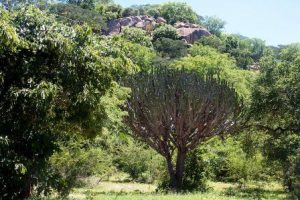
Euphorbia ingens. Photo: Bart Wursten. Source: Flora of Zimbabwe
June Davies very kindly invited us to Woodleigh Farm and what an idyllic place it is. There were still signs of the dreadful frost that devastated us in 1994. Coppice growth was vigorous, except where whole huge Euphorbia ingens hung, crooked, black and broken.
We wandered at will and were absolutely enchanted by the incredible floral display that unfolded at out feet as we proceeded. What appeared to be a creeper proliferated, first all over the ground and then up whatever trees it happened upon. It was suspected that it was Clematis, but the emerging fruit was somehow not right. A little later it appeared again but had a well-developed trunk and ripe fruits which yielded up its secret. A Clerodendrum it was indeed! Lurking near the shore of the dam was a stapeliad, Duvalia polita, and in another locality Anton found a Rhaphionacme, and Cryptolepis cryptolepioides, while I saw Sarcostemma viminale very heavily grazed. These were the only four Asclepiad/Periplocaceae plants encountered. Clematopsis scabiosifolia (Shock-headed Peter) raised its elegant pink heads and the Lily family was generously represented by several species of Amaryllis. It was interesting to notice how the Fan Lily, Boophone disticha like the Sarcostemma was singled out as a delicacy by the stock. Aloe greatheadii was also extensively munched at. Pig melons were sprouting all over, and June told us that this fruit forms a staple part of her herd’s diet. The seeds being fertilised by proceeding through the gastric tract, germinate readily.
The Euphorbiaceae were only represented by Euphorbia ingens, and the dwarf, clumping Euphorbia espinosa. The wild foxglove Ceratotheca triloba had left behind its wicked hooked seeds which can inflict considerable damage on the unwary and unsuspecting appendage or digit.
We lunched near the dam and surprisingly enough, were little molested by flies, another unexpected pleasure.
On another part of the farm Colophospermum mopane grow on the sodic soils they favour. The Acacia thorns were the dominant trees, with eight species represented. Over 75 different trees were noted, among the diverse, numerous and strikingly beautiful flowers.
We thank you, June, most warmly, for allowing us to share your gorgeous environment, and hope you will ask us again
-NORMA HUGHES.
Lack of space sadly prevents the listing of all the species seen, but the collector of data for the mapping project is delighted to have such a comprehensive list.
ANDY MACNAUGHTAN CHAIRMAN


